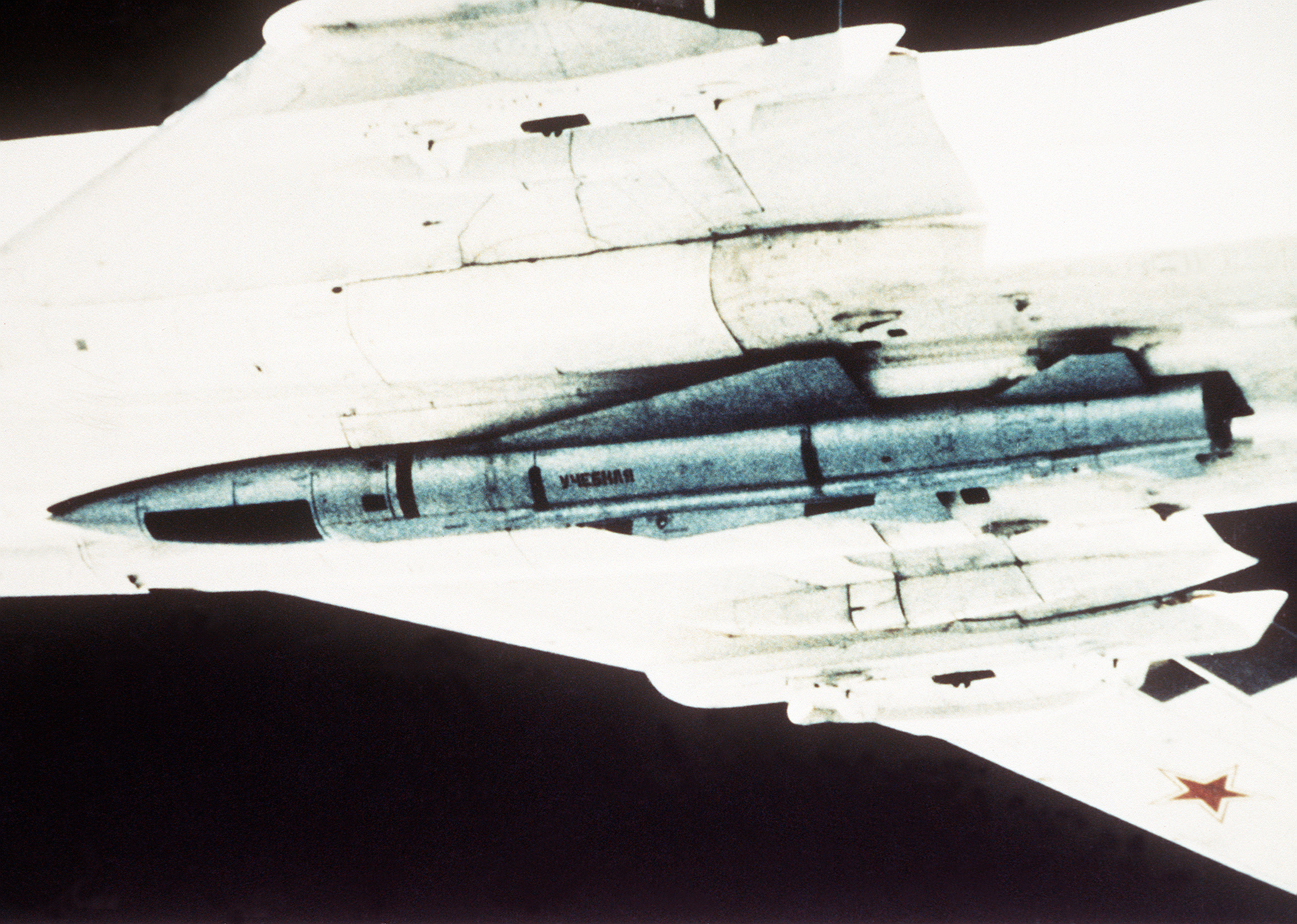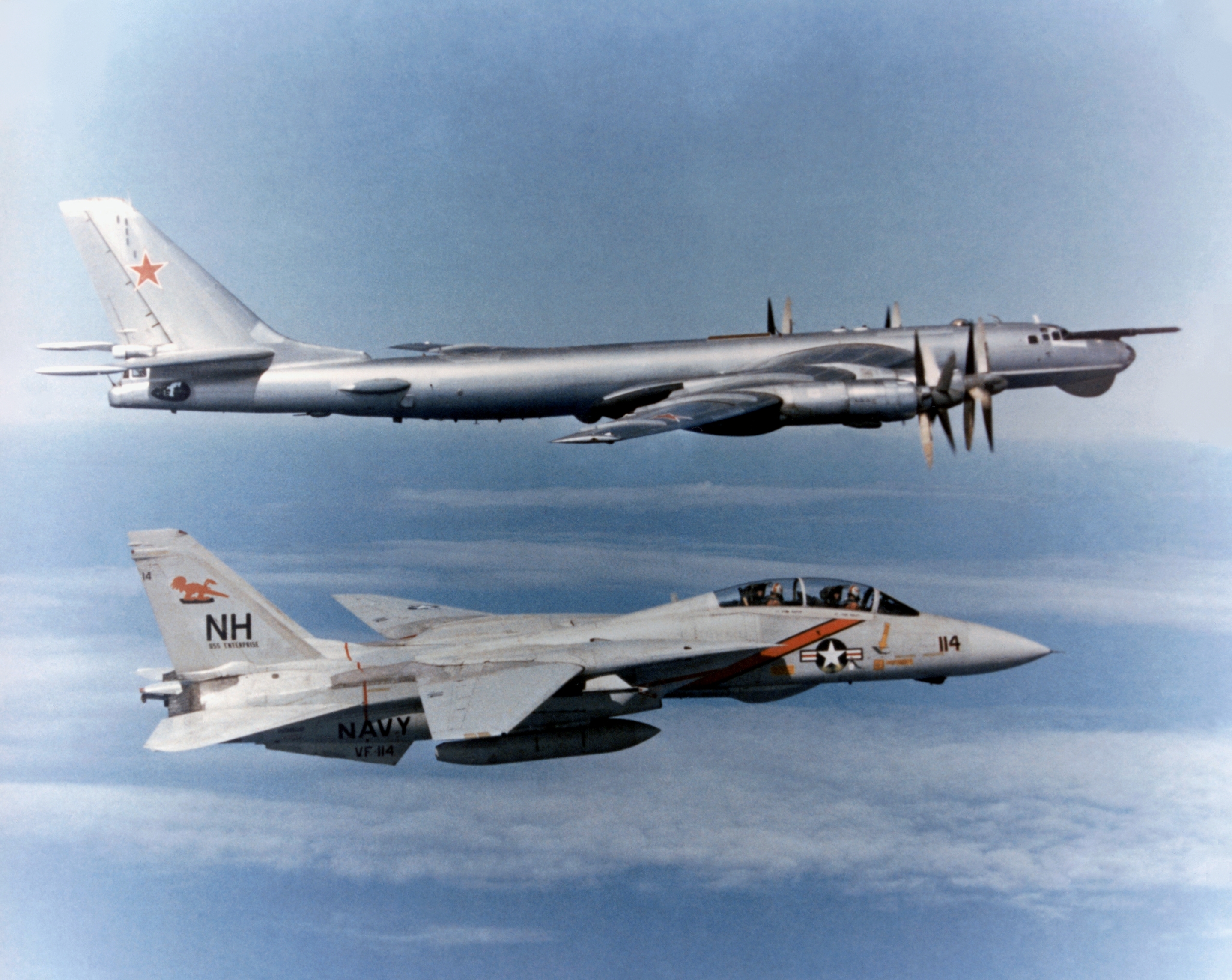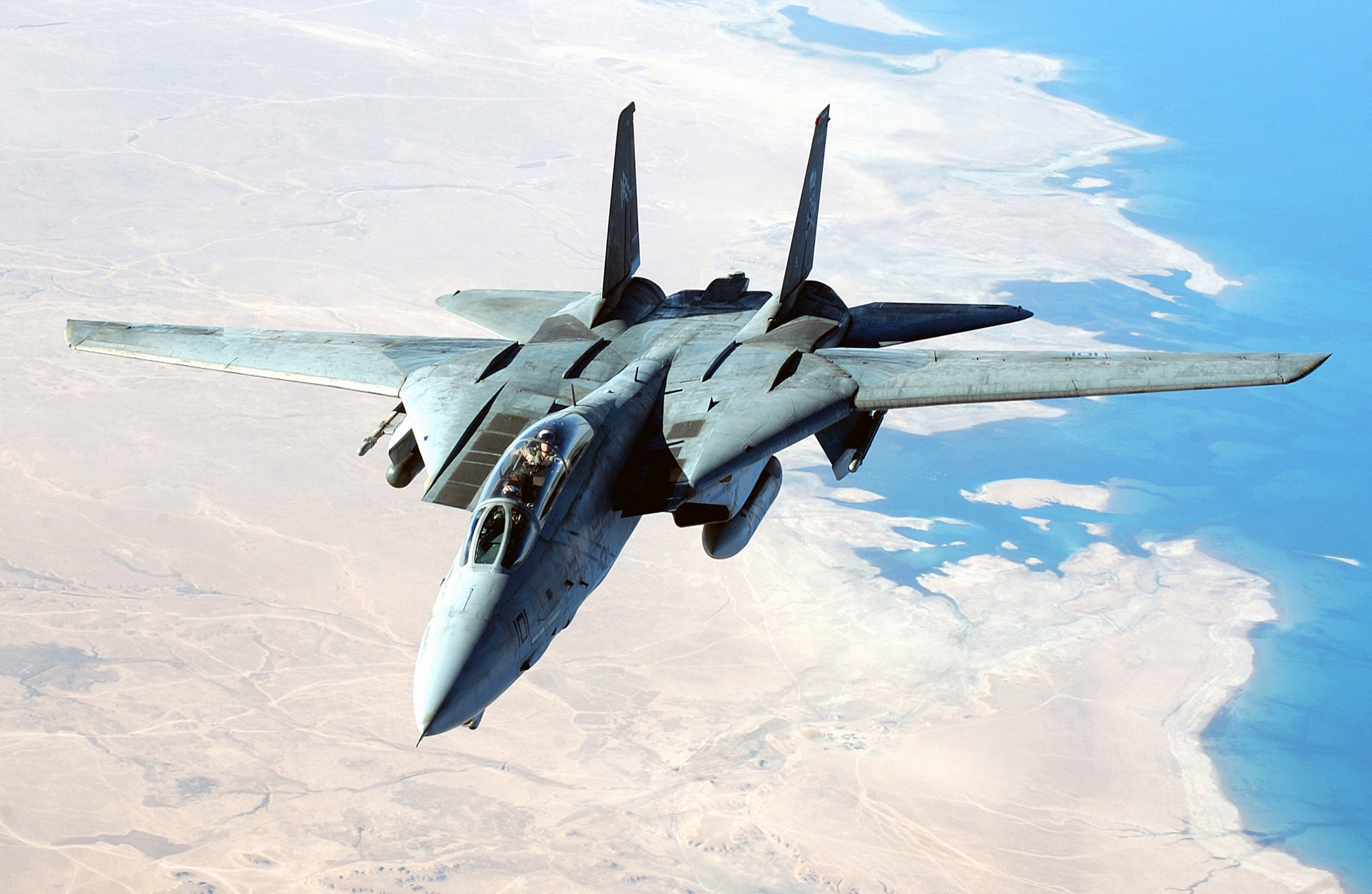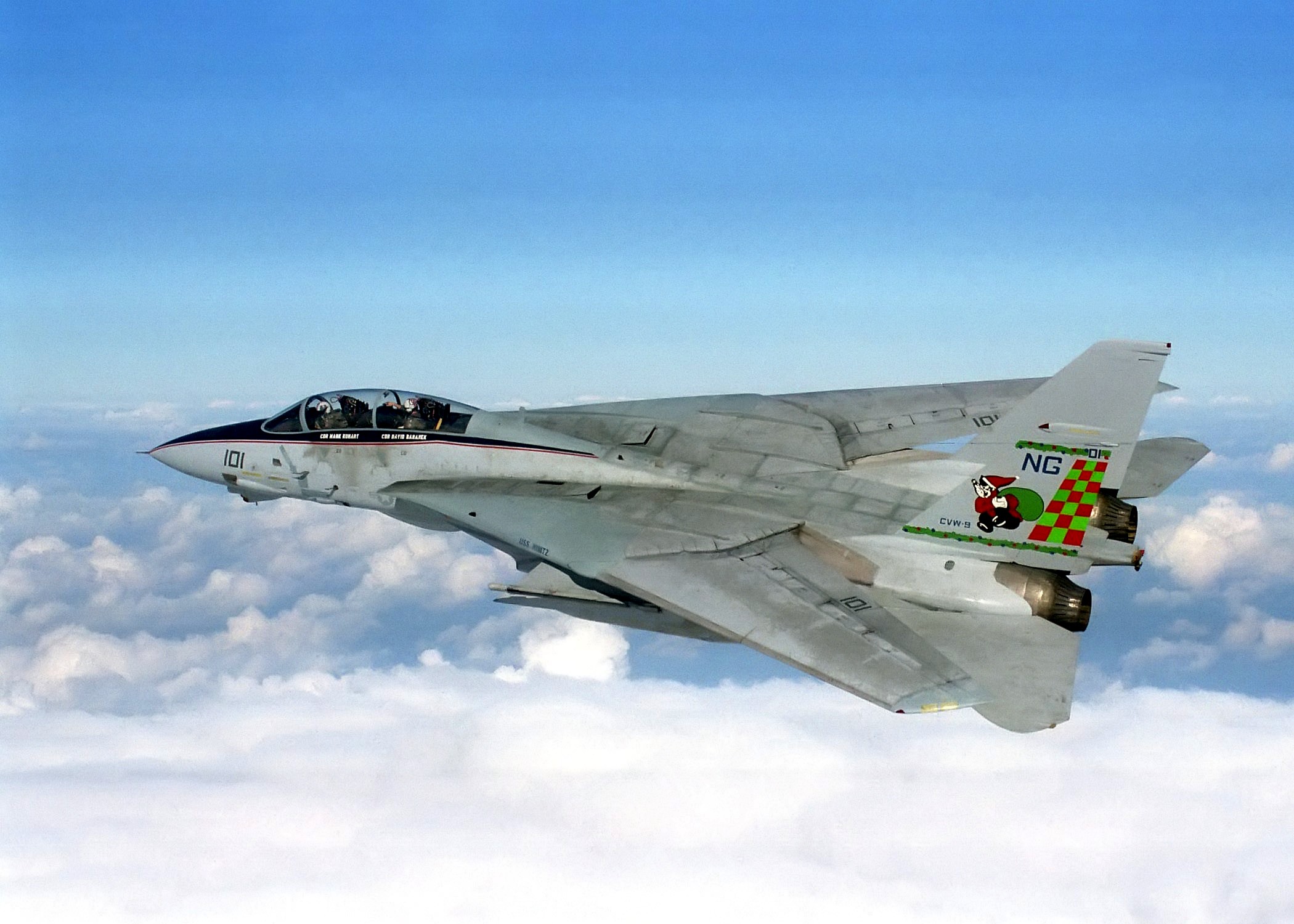F-14 principal role was fleet air defence, designed as an air superiority fighter and long range interceptor it was a large high performance carrier-borne.
The F-14 was the second american variable-sweep wing fighter aircraft after F-111. This variable-sweep wings allowed F-14 low speed approaches to carriers and manouvers with the wings swept forward and high speed interception and climb with swept back wings. Variable-sweep mechanism was fully automated so controlling the aircraft was much easier and pilot could concentrate on other more important tasks.
The F-14 was two-seated aircraft in all versions as its predecessor the F-4 Phantom II. F-14 operated with a crew fo two, a pilot and a radar officer known as RIO (Radar Interceptor Officer) who was in charge of radar, intelligence and weapon systems.
The F-14 was two-seated aircraft in all versions as its predecessor the F-4 Phantom II. F-14 operated with a crew fo two, a pilot and a radar officer known as RIO (Radar Interceptor Officer) who was in charge of radar, intelligence and weapon systems.
 |
| F-14 SuperTomcat en el Intrepid Air and Space Museum |
 |
| Misil AIM-54 Phoenix |
 |
| Kh-22 under a Tu-22M2 |
AWG-9 radar could track up to 24 airborne targets, display 18 of them on the cockpit displays, and fire AIM-54 Phoenix missiles against 6 of them at the same time.The accuracy of this weapon systems was estimated on the 80%.
 |
| AN/AWG-9 Radar (via www.gcblue.com) |
 |
| F-14 Tomcat intercepting a Tu-95 "Bear". |
Sidra Gulf Incidents
The F-14 has been involved in two incidents with Lybian to over the Sidra Gulf. The first one took place on August 19th 1981 when two Lybian Su-22 "Fitter" attacked with an AA-2 "Atoll" air-to-air missile two F-14's of VF-41 squadron based on USS Nimitz carrier. The missile was dodged by the F-14 after which the F-14 open fire. After launching the missile both Su-22 lead to their air base trying being both of them destroyed by a AIM-9 Sidewinder missiles launched by the F-14's. According to the U.S. Navy official briefing both Lybian pilots ejected and were safely rescued.
On January 4th 1989 another combat between F-14 and Lybian aircraft ocurred over the Gulf of Sidra. This time the Lybian aircraft were soviet made MIG-23 "Flogger". At this confrontation F-14 were cleared for firing before being fired as they felt hostigated by the MIG's. After the launch of two AIM-7 "Sparrow" radar guided missiles that couldn't track their targets the U.S. aircraft fired two more missiles another AIM-7 and one AIM-9 "Sidewinder" which finally detroyed both MIG's-
General characteristics (Via Wikipedia)
General characteristics (Via Wikipedia)
- Crew: 2 (Pilot and Radar Intercept Officer)
- Length: 62 ft 9 in (19.1 m)
- Wingspan:
- Spread: 64 ft (19.55 m)
- Swept: 38 ft (11.58 m)
- Height: 16 ft (4.88 m)
- Wing area: 565 ft² (54.5 m²)
- Airfoil: NACA 64A209.65 mod root, 64A208.91 mod tip
- Empty weight: 43,735 lb (19,838 kg)
- Loaded weight: 61,000 lb (27,700 kg)
- Max takeoff weight: 74,350 lb (33,720 kg)
- Powerplant: 2 × General Electric F110-GE-400 afterburning turbofans
- Dry thrust: 13,810 lbf (61.4 kN) each
- Thrust with afterburner: 27,800 lbf (123.7 kN) each
- Maximum fuel capacity: 16,200 lb internal; 20,000 lb with 2x 267 gallon external tanks[30]
- Maximum speed: Mach 2.34 (1,544 mph, 2,485 km/h) at high altitude
- Combat radius: 500 nmi (575 mi, 926 km)
- Ferry range: 1,600 nmi (1,840 mi, 2,960 km)
- Service ceiling: 50,000 ft (15,200 m)
- Rate of climb: >45,000 ft/min (229 m/s)
- Wing loading: 113.4 lb/ft² (553.9 kg/m²)
- Thrust/weight: 0.91
- Guns: 1× 20 mm (0.787 in) M61 Vulcan 6-barreled gatling cannon, with 675 rounds
- Hardpoints: 10 total: 6× under-fuselage, 2× under nacelles and 2× on wing gloves[87][N 2] with a capacity of 14,500 lb (6,600 kg) of ordnance and fuel tanks[36]
- Missiles: ** Air-to-air missiles: AIM-54 Phoenix, AIM-7 Sparrow, AIM-9 Sidewinder
- Loading configurations:
- 2× AIM-9 + 6× AIM-54 (Rarely used due to weight stress on airframe)
- 2× AIM-9 + 2× AIM-54 + 3× AIM-7 (Most common load during Cold War era)
- 2× AIM-9 + 4× AIM-54 + 2× AIM-7
- 2× AIM-9 + 6× AIM-7
- 4× AIM-9 + 4× AIM-54
- 4× AIM-9 + 4× AIM-7
- Bombs: ** JDAM Precision-guided munition (PGMs)
- Paveway series of Laser guided bombs
- Mk 80 series of unguided iron bombs
- Mk 20 Rockeye II
- Others:
- Tactical Airborne Reconnaissance Pod System (TARPS)
- LANTIRN targeting pod
- 2× 267 USgal (1,010 l; 222 imp gal) drop tanks for extended range/loitering time
- Hughes AN/APG-71 radar
- AN/ASN-130 INS, IRST, TCS
- Remotely Operated Video Enhanced Receiver (ROVER) upgrade



No comments:
Post a Comment